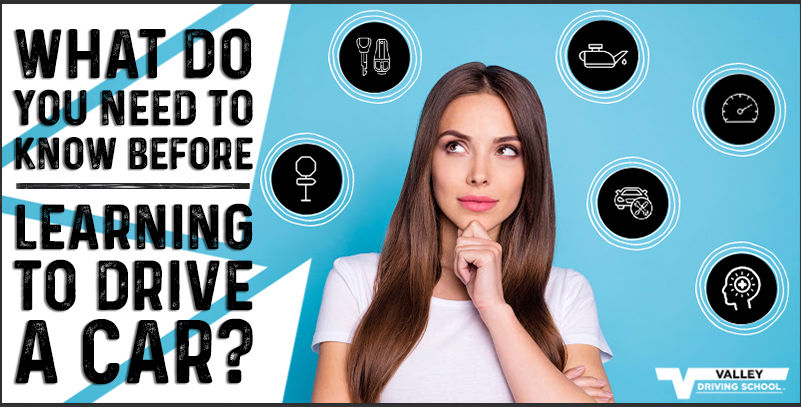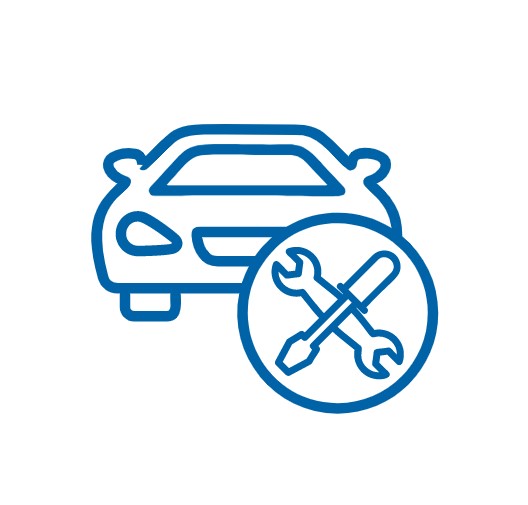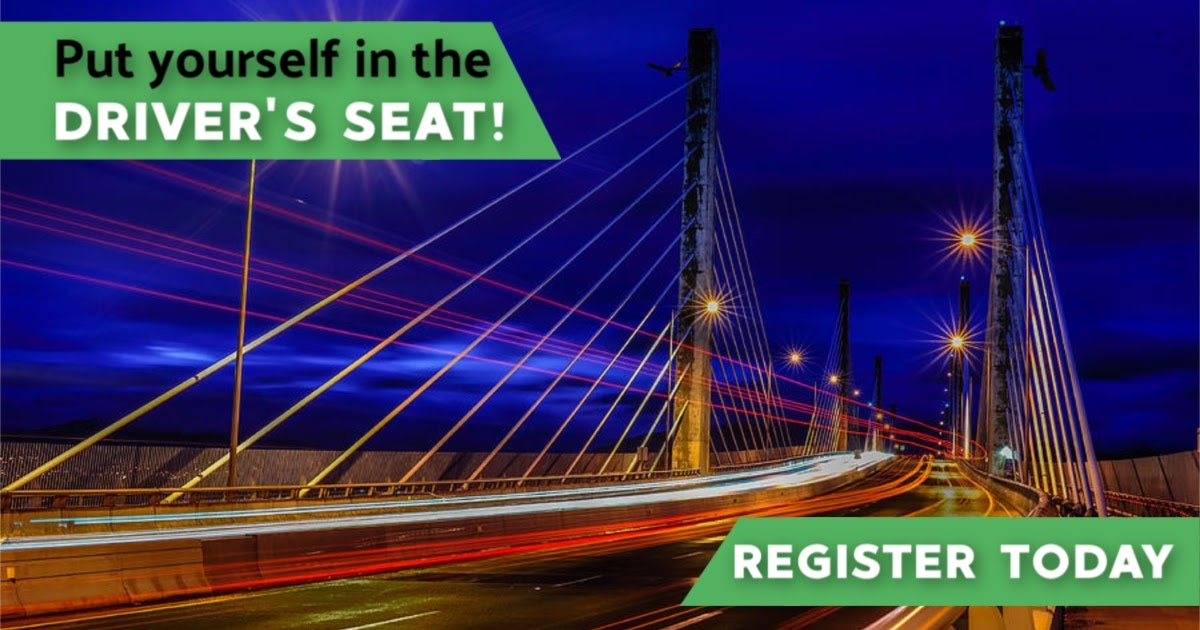Learning to drive is an exciting time for most individuals. The prospect of driving alone and having the freedom to go wherever you want, whenever you want, is a tantalizing idea that helps us enthusiastically approach the learning portion of our driving careers.

Before you can confidently and safely get behind the wheel and begin the process of learning to drive, there are many things you can do and learn beforehand to help your individual learning curve. A good base of knowledge about cars, their functions, basic traffic situations, road signs and even some quintessential maintenance tips go a long way when you first start this journey.
In this post we’ll outline some of the things that you should know before you put the vehicle into drive.
 The Right Attitude
The Right Attitude
Valley Driving School’s own resident Driving Instructor, Tracey Dyck, notes while it’s critical to have a solid and basic understanding of the mechanical inner workings of vehicles and how they function, learning to drive always begins with a competent and eager driver who posses a desire to learn and accepts responsibility for one’s own learning outcome.
“New drivers must come prepared with a willingness to accept constructive/corrective feedback - and fully acknowledge that driving is a privilege,” says Dyck. “They have to be open to try new and different methods of driving they may not be used to, and they must possess self awareness; that’s critical to recognizing the importance of safety while driving.” Dyck adds that all successful new drivers share two common traits: they show up prepared - both mentally and physically - to learn to drive, and are advocates of lifelong learning.
In addition to being ready to tackle driving lessons and the intricacies of the road, new drivers should also come prepared to make mistakes. They’re inevitable, and expected - so don’t beat yourself up too much when something less than ideal happens. Be prepared for other road users who may not be patient or understanding with new drivers, and allow yourself the appropriate time to develop skills from simple to complex.
 Basic Car, Engine & Transmission Knowledge
Basic Car, Engine & Transmission Knowledge
What makes a car go? The engine and transmission, that’s right! We’re not saying you should be a star mechanic, or an engineer - but having some basic knowledge of the functions and operation of your vehicle’s working and integral parts is a good way to familiarize yourself with the machine before operating it.
If you have an automatic transmission, for example, knowing when and how to shift into gear is a basic skill that will not only allow you to go, but it’ll shed some light on the fragility and potential for repair of your transmission and engine. If you have a shiftronic transmission feature, knowing when you’re able to safely and efficiently downshift in traffic is a great skill to know - and further, if you have a manual transmission, knowing about the complex relationship between clutch, flywheel and engine is a bit of knowledge that can help to translate the muscle memory you’ll need to drive without grinding gears too badly.
This knowledge should also extend to involve some numbers. It’s critically important that you know how much power your vehicle possesses and what you should expect in terms of delivery of that power; sometimes a new driver can be taken by surprise, so knowing a bit about your engine and transmission is a good way to ease into the role of driver.
 Gauges & Features
Gauges & Features
Now that you’ve paid your respects to the vehicle itself by getting to know its mechanics and power, this is the perfect time to grow upon your knowledge of the vehicle. Knowing your way around the instrument cluster is paramount to using and operating the vehicle safely.
Give yourself the proper amount of time to familiarize yourself with the instrument cluster; tachometer and speedometer, turn signal placement, lights, power mirror and seat controls, the heated seats, A/C, defrost, and all applicable engine lights and alerts - like oil temperature, fuel gauge, door ajar notices, etc.
These gauges and features are your vehicle’s way of communicating with you, and allowing you to communicate with other drivers. All these gauges, notices, lights, and warnings will help you to further understand the intricacies and moving parts involved with being a knowledgeable and confident driver.
 Accessories
Accessories
Inside your vehicle there may be many modern driver aids included in fairly newer vehicles - from heads up displays, automatic lane departure alerts, blind spot monitors, running lights, heated/cooling seats, memory-adjusted seats, etc. These accessories help make the experience of driving a more luxurious, more enjoyable - and sometimes easier - experience, and may take time to get to know.
Take some time out in the driveway or the parking lot to find yourself the perfect driving position, the ideal steering wheel location, find the moonroof controls, locate the stereo controls, and master the remote starter.
While none of these things are integral to learning how to drive, they help you to get used to the features and locations of your cars buttons and switches and will eliminate confusion while driving down the road. Knowing where everything is ahead of time will allow you to keep your eyes and attention on the road.
 Basic Maintenance
Basic Maintenance
Many people enjoy teaching their young ones how to drive - and some of them are more, shall we say, serious, about the experience than others. While there’s a time and place for everything, we believe that having some basic knowledge of how to take care of your vehicle - even in minor ways will help you to keep the car in good working order, and can help get you out of a jam down the line if you ever run into problems road-side.
Your mentor may be thinking along the lines of being able to read a tire pressure gauge, change a tire, know when/how to change the oil on your vehicle, refill the washer fluid reservoir, or how to jumpstart your car. These simple, everyday tasks keep your vehicle running in tip-top shape and allow you to focus on driving, not getting to the next gas station or service centre for help.
 Road Signs & Basic Traffic Functions
Road Signs & Basic Traffic Functions
Some of the most important knowledge that you can learn before getting behind the wheel of a car are the basic rules of the road. New drivers need to have a good sense of road rules; from the more obvious ones like stop and yield signs, to chevrons, round-about etiquette, intersections and all-way stops, inner city junctions, etc. All of these unique signs and traffic situations require patience, discipline, confidence and safety as key factors to driving success.
Consider heading out for a leisurely learning drive with your parent, guardian, or a trustworthy friend who has had their full licence for some time. This experience will allow you to ask questions, and view first-hand the ways that experienced and safe drivers conduct themselves in traffic scenarios. Ask about the signs you see, inquire about pedestrian stops, watch attentively when and where the driver checks their mirrors and blind spots, etc. All these basic functions are a part of learning to drive, and a good idea of when and how to use this knowledge is a great stepping stone on your way to learning to drive yourself.
-----
Learning to drive can be a fun and invigorating process, especially when you take the time to learn about the process of driving, and all the intricacies that operating a motor vehicle brings to the table. There are many ways you can learn about the ways of the road, such as the Graduated Licencing Program, so take your time to invest some solid research into basic road theory, and be sure to get out on the road with a qualified supervisor so you can see and understand how they interact with their vehicle and other drivers.
Lastly, remember to always respect your vehicle. There’s a lot of people relying on each other for safety and knowledge when driving. Take the time to learn about your specific vehicle, what’s needed to operate it, and how to put your best foot forward. Learning to drive is a true process that takes time, experience, and understanding - take it all in!

